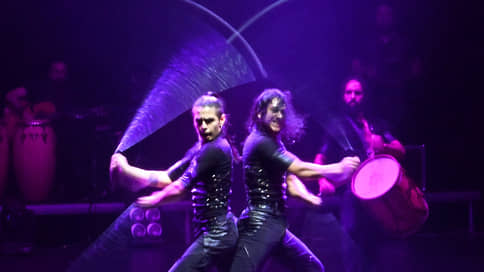The XVI Chekhov Festival ended with dances from the Argentine troupe Malevo
[ad_1]

On the stage of the Mossovet Theater, the performance of the Argentine troupe Malevo ended the XVI Chekhov Festival, which brought together 15 performances from different countries in its international program. Tells Tatiana Kuznetsova.
The Chekhov Festival, which stretched over an incredible four and a half months, opened and ended with Argentine passions: in May, Muscovites were presented with “Wild Tango” by the troupe of German Cornejo (see “Kommersant” on May 26), in October – “Malevo Xtreme” by the company of Matias Jaime. Both directors are well aware of the commercial potential of national Argentine dances, both use show techniques, emphasizing the need to keep up with the times, but achieve opposite artistic results. Germán Cornejo, in his desire to entertain, sacrifices tango itself, practically dissolving it in a kitschy symbiosis with the circus and all kinds of acrobatics. Matias Jaime manages not to betray the national art: against the backdrop of a typical pop light score, natural malambo reigns on stage for all 90 minutes – the most ancient dance of the country.
Invented by declassed gaucho shepherds, it was born half a millennium ago. Born in the endless Argentine pampa, malambo surprisingly ignores space: for this dance of adventurous singles, a patch of one meter by one meter is enough. According to the plan, he reproduced the clatter of hooves and prancing of horses. But its essence and form is a battle: the winner is the one who invents and performs the most intricate and tricky mudanzas – combinations of movements that combine zapateado-tapping borrowed from the Spaniards with sepilados – overlapping and twisting of the legs in all joints, from the groin to the knees and ankles. Over time, they began to “fight” in pairs or teams, and additional “weapons” were included in the battle – bombos drums, brought to Argentina by black slaves, and shepherd’s lassos with stones tied at the ends – boleadoras. The dazzling, rapid rotations of the ropes, accompanied by the crushing of stones on the ground, incredibly complicated the already difficult rhythm of tapping, and the coherence of the work of arms and legs required incredible coordination. In such a dance there is no time for fun and coquetry with the audience: the body leans forward, the face is stern, the unseeing gaze pierces the horizon, breathing requires control and concentration, movement requires complete dedication. The poor gauchos beat their zapateados with bare heels, the successful ones with boots with rough soles lined with nails.
Unlike tango, which is taught by anyone, anywhere – from Madagascar to Iceland, there are very few malambo schools. This traumatic art of gambling is most often inherited. “Malevo”, which became a troupe and became famous in 2016 thanks to participation in a television competition, initially consisted of just such hereditary fans – carpenters, masons, bakers by their main profession. And even now, seven years after the first triumph, there is not a trace of professional fatigue in the company’s artists – with its false excitement, habitual demonstration of enthusiasm and stereotyped methods of squeezing out applause.
The thirteen “bad boys” of “Malevo”, together with four musicians (violin, guitar, bandoneon and two drum kits – traditional and modern) give their all as if the main prize of a lifetime is at stake. There are no other signs of “amateur performance”: each artist is a virtuoso, each manages to maintain his own identity despite the strict corps de ballet training. The coherence of crowded numbers, the speed of changeovers and the synchronization of performance are ideal, on which the very lives of the dancers often depend. As, for example, in the mass rotation of the murderous boleadoras – the slightest change in the trajectory of the metal balls that replaced the authentic stones can lead to fatal injury.
Born by men and for men, today malambo looks like a trap for women – exciting and extremely erotic. Thirteen machos for every taste – flexible thin young men, broad-shouldered stately cowboys, sly womanizers, stern men with “wet” hair pulled back into a ponytail or curly over the shoulders, in tight black trousers with bare torsos or in tight shirts: a fountain of sex appeal gushing from the stage became an exotic gift for Moscow residents, who knew malambo only in the interpretation of the Moiseev ensemble – a serene mixture of “French with Nizhny Novgorod”.
[ad_2]
Source link






